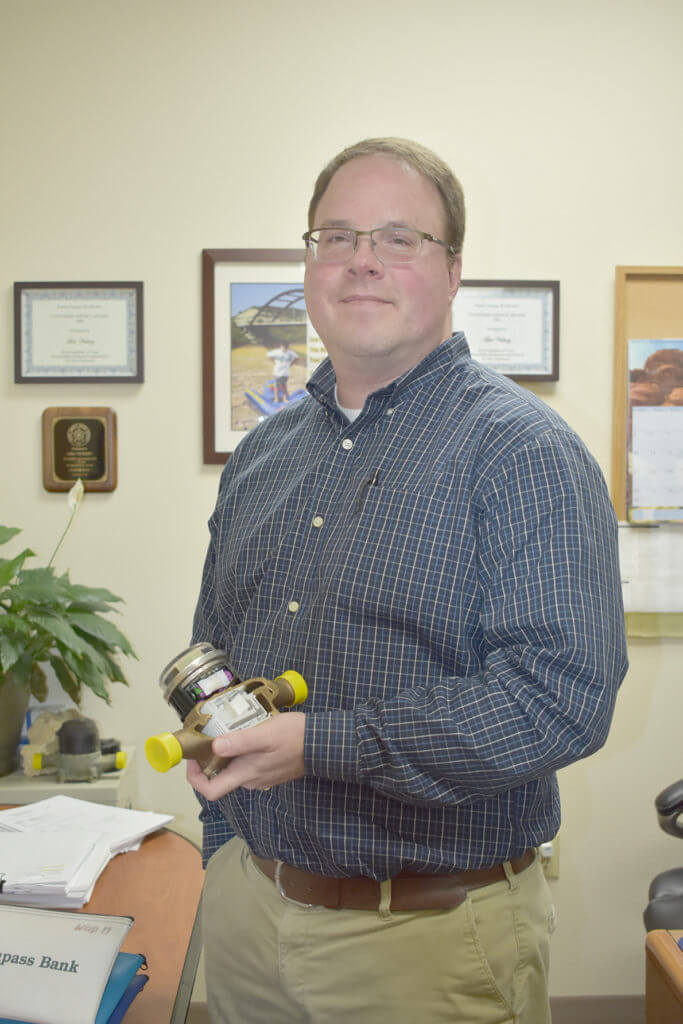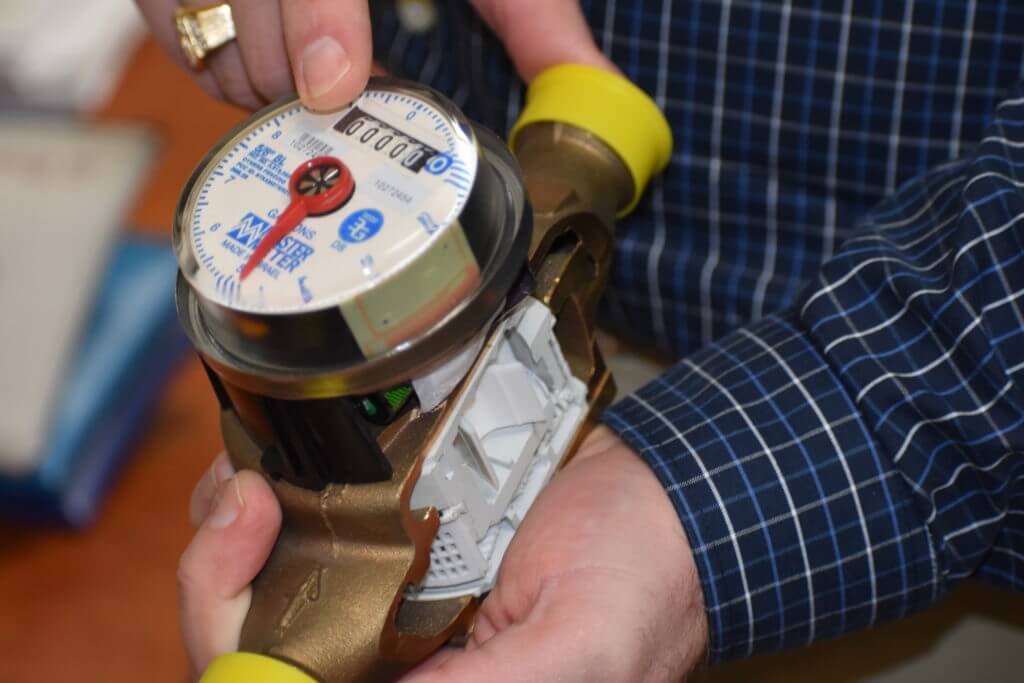
Jason Homan, general manager of Travis
County Water Control and Improvement
District 17, explains how a water meter operates
By LESLEE BASSMAN, Four Points News
Steiner Ranch resident Nancy Phillips said she was concerned when she received her Nov. 22 water bill from her provider, Travis County Water Control and Improvement District 17. The statement showed about twice the amount of gallons of water she and her spouse consumed from the month prior, and near what the couple consumed during the summer months when their irrigation system was in use, she said.
“What was startling was the (November water) usage because, during the summer, when you are watering twice a week, you don’t expect to see the same usage in November when you’re not,” said Phillips, who lives in The Plateau. “And, as far as we know, we don’t have any leaks.”
WCID 17 General Manager Jason Homan, who is also a resident of Steiner Ranch, said his billing clerks have received some calls recently from district customers noting an increase in their bills.
“We’ve gotten quite a few calls, I would say, from the end of October through the first week of November,” he said about customers reporting high water bills although the district does not maintain a record of complaint calls. “It’s not abnormal — October and November are common times for people to be concerned with their water bills. A lot of that goes back to the issue of irrigation. In the winter time here, grass goes dormant so most of us take advantage of that fact and turn off our irrigation systems. For people, depending on when they turned (the irrigation system) off, will depend greatly on what their bill is going to reflect.”
Homan, who relocated to Austin from the northwest in May, said he has had some customers tell him their irrigation system was off during this time period. However, once he pulls a graph showing their water usage in time increments, he said most say they did not realize their irrigation system was in operation when they thought it was shut off.
Investigating the source of a high water bill
Palisades resident Gilbert Benavides said he has seen his WCID 17 water bill spike to almost double of what it was in 2012, the year he moved into his Steiner Ranch home with his wife and young son. Although he uses technology to monitor his irrigation system, Benavides said his bills remain constant, reflecting the same water usage in the winter as in the summer, even during week-long periods when his family is out of town.
“Because I can control my irrigation through my phone, I turn (the irrigation system) off during the winter,” Benavides said of the $300 program he uses.”The December bill was the same as July when the irrigation system was on. I’ve always wondered why my bills are so high since the water is controlled.”
Citing an article in which a local water utility estimated customers’ water usage, Homan said WCID 17’s water bills “are all 100 percent driven from the meter, what it communicates to us in the district.”
“Everything is based purely on what water is passed through someone’s meter,” he said. “So when people get concerned about how much water they’ve been using, what we try to do is encourage them to call here in the office and to speak with our billing clerks.”
When a call comes into the district, he said the clerk will review how the customer uses his or her water, including whether or not they have a swimming pool or irrigation system, trying to identify whether or not the potential exists to have a water leak in the home.
“One of the simple things that people can do is turn off everything in their home, verify that their toilets are not running and go out to their water box to see whether the meter is spinning,” Homan said. “If the meter is spinning, they have a leak and they need to call a plumber and have that looked into.”
If a leak is not discovered by the homeowner, he or she can take advantage of a free service offered by the district that will include a complete audit of the customer’s irrigation system by a licensed irrigator, Brian Dunn, who is employed by WCID 17, Homan said. After the audit, a district billing clerk will show the user a complete calculation of how much water he or she uses every time the irrigation system runs, he said.
“For someone with a large lot that has a 45-minute watering cycle, they could use 4,000 gallons in one watering cycle,” Homan said. “It can be very eye opening for people when they finally see that.”
If the irrigation system is ruled out as a the source of a leak, he said the billing clerk will review a customer’s water usage graphs to determine if another event, such as a leaking toilet, is the cause for the high water bill, an issue that Homan said can expend hundreds of gallons of water in a single day.
“If you’ve got four or five toilets in your home and three of them are running, it seems like a trickle flow shouldn’t add up that much,” he said. “People have a hard time understanding that even small trickle flows, even a quarter of an inch, can add up to 1,000 gallons over the course of a day.”
Automatic pool filters or swimming pool leaks can sometimes be the culprit of a high water bill, Homan said.
During his family’s first three months in Steiner Ranch, he said his water bills were in line with the previous homeowner’s bills. He started out filling his swimming pool twice a week but soon needed to fill the pool daily, he said.
“It turns out (the home) had a pool leak ongoing probably for greater than a year,” Homan said. “The previous homeowners had been paying their water bill the whole time with this pool leak because the automatic filler is just refilling the pool, refilling the pool. We’ve cut 20,000 gallons a month out of our usage just from that and it was completely unnoticeable until it got to a point where it was leaking so badly that the pool was visibly lower. There’s a lot of sneaky things out there and that’s what is so important about having a (water usage) graph to show people.”
Finally, if the customer still cannot determine the basis for the high water usage, the district can pull the water meter out of the ground and send it off to be tested for accuracy, he said.
“We get those results back and get them to the homeowner to let them know and, if for some reason the meter was not operating properly, we would adjust (his or her) bill accordingly,” Homan said.
All of WCID 17’s meters are mandated to be at least 95 percent accurate and Homan said he is not aware of a situation in which a district meter failed to the district’s advantage (see sidebar).
Donna Poursepanj said her August water bill from WCID 17 was “exceptionally high.”
“The bill we got is about six times our normal bill,” the Steiner Ranch resident said. “In the summertime, we might average $125 or $150 (a month). That bill was $650. The highest bill to date didn’t even get up to $200.”
Right after she opened up the August bill, Poursanj received a telephone call from a WCID 17 staffer informing her that the bill was running about six times what it had been at the same time the previous year.
The type of meters used by WCID 17 allows the meter to send a radio wave to district trucks that slowly drive through the district’s coverage area, Homan said. These radio waves are recorded and read by technicians in the office, he said.
“Anything that is greater than 20 percent higher than normal usage is something we’ll take a look at,” Homan said. “And, we will call the homeowner and say, ‘you have a high water situation here.’”
Poursanj said she reviewed all of the possible sources for the leak, but came up empty. However, when she looked over her water usage graphs with the district’s billing clerk, the mystery was solved.
“We found there must have been a power (outage) where the electricity shut down and came back on again,” Poursanj said. “It caused our (sprinkler) box to somehow reset. Our timer was the same except in the morning hours (the sprinkler system) was running twice. I didn’t even know this was possible.”
Recourse for a high water bill determination
A customer can appeal a water bill to Homan himself who said he will review the district’s water usage graphs directly with the homeowner. If the customer still does not agree with Homan’s decision, he or she can appeal to WCID 17’s board of directors, the district’s publicly-elected officials, he said.
“Unlike the city of Austin and some larger districts where the water entity itself is the final authority, we allow any homeowner to come in and appeal any ruling—that I make or my staff makes—to the Board of Directors,” Homan said.
Payment plans are also regularly used by the district, he said.
The district has a process that will allow a customer to receive an adjustment to his or her bill, once a year, for an unintentional water loss due to a leak, Homan said. The customer must still pay for the water used, but at a reduced rate. This adjustment is provided only if the leak is repaired, proof of the repair is submitted to WCID 17 and no adjustments are offered for “irrigation over-use” or “fixtures left on, even if unintentional.”
As for Phillips, she said she is sure her sprinkler system is off but cannot determine whether or not a leak exists in her home.
“I don’t have enough data to know what’s going on,” Phillips said of the November water bill calculation that was double her October statement. “What I’d like to do is get another data point and see what the next bill is. And again, if it is unusually high, something’s going on and we’ll definitely investigate it further. Until I get the bill, I’d be flying blind.”
How does a water meter work?
A meter is just a spinning wheel, trapped inside a meter box, with a pipe going into and out of the box, said Jason Homan, general manager of Travis County Water Control and Improvement District 17.
“The only time (a wheel) can spin is when water is flowing past it,” he said. “It can’t spin, (meaning) it’s hydraulically locked, when there’s no (water) flow. The water has to flow by this wheel and it spins it as it flows by, like a water wheel.”
The spinning motion is what turns the meter and the meter clicks off how many gallons are used, Homan said. If there’s no flow, the meter can’t move, he said.
In a high salt area with a lot of calcium and magnesium deposits in the water, such as WCID 17’s coverage area, those deposits can build up in a meter over the course of a decade, Homan said.
“(The wheel) may spin slower than it should be but we’ve never had one, to my knowledge, that has (spun) faster,” he said. “It’s against the law of physics.”


